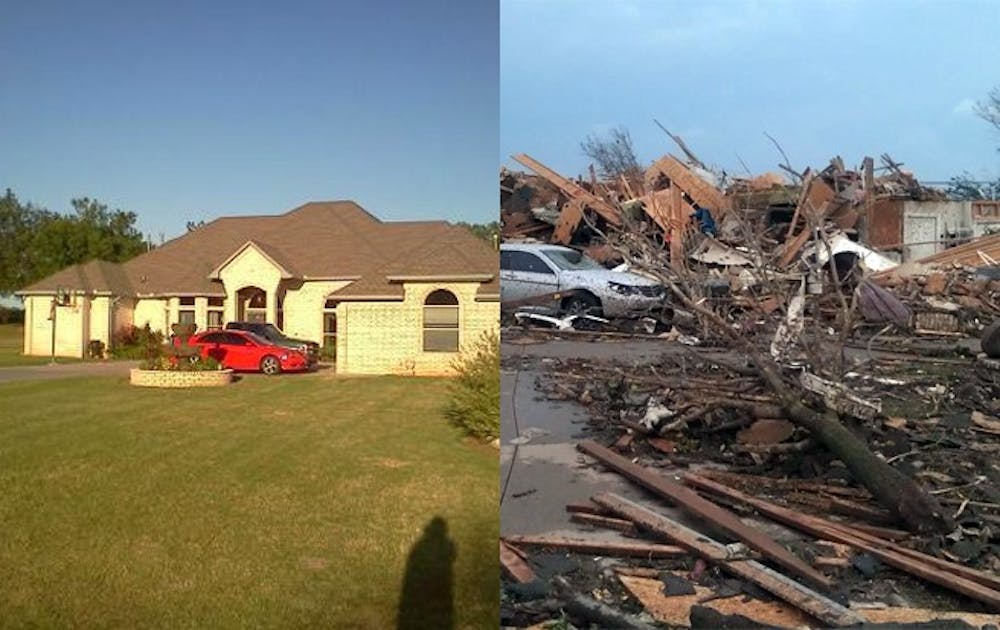From afar the tornado looked like nothing out of the ordinary, said junior Anastasia Hunt.
Hunt and her mother assumed that the skinny-looking tornado heading toward their home in Moore, Okla. would pass through with little damage done to their town. A couple of minutes later, however, the two would notice a completely different reality brewing outside. Running to a tornado shelter in time, Hunt and her mother remained safe as the 1.3-mile-wide tornado bore down on the suburban town.
Their home, however, was less fortunate. The tornado completely destroyed the Hunt family’s house and almost all of their possessions.
“It hasn’t really hit me yet,” Hunt said. “Right now I am more focused on the fact that I am actually alive.”
It is currently estimated that the Oklahoma tornado has killed at least 91 people and injured 145, according to The New York Times.
The National Weather Service classified the tornado as an EF5, the most powerful type of tornado that exists. EF5 tornadoes are estimated to have windspeeds higher than 200 mph on the Enhanced Fujita Scale, which rates the strength of tornadoes in the United States and Canada.
Only 58 EF5 tornadoes have occurred in the United States since 1950.
Nobody in Hunt’s family was hurt, but they were forced to relocate to Oklahoma City. Hunt noted that her family had been renting out a house there to a tenant who moved out Saturday, so they are able to stay in the house for the time being.
She noted that it will be a long and expensive process to replace everything that the family has lost.
“We definitely didn’t think it would be this dangerous,” she said. “I went to get a glass of water and I came back with my mom and the tornado had gotten so large in a matter of two minutes.”
Brian Self, a senior who also lives in Moore, said that the tornado hit a mile south of his house and, therefore, did not cause any structural damages. His water, however, has been shut off for two days.
“Currently my immediate surroundings around my house are normal, but if I drive a mile south it looks like a war zone,” he said. “Buildings and houses that I drove by every day are no longer there.”
The Oklahoma tornado did not behave in the way most tornadoes do, said Bob Healy, professor emeritus of environmental policy in the Nicholas School of the Environment. Typically, tornadoes move up and down, which causes damage in several areas. Monday’s tornado was different, however, in that it stayed in one spot, he said.
Hunt said she did not flee the tornado initially because she expected it to pass over her town in the typical manner.
“We didn’t think it was a big deal because they usually come down, but then go back up,” she said.
Healy also noted that tornados are much harder to prepare for than hurricanes because there is little advanced warning for tornados. Hurricanes can be forecasted up to 12 hours in advance, but people may receive tornado warnings as little as 15 minutes before an oncoming tornado hits.
“Honestly, there wasn’t much time to do anything once we were warned of the tornado,” Self said. “We were given 45 minutes of warning from when the tornado first struck to when it had devastated my entire city.”
Healy added that since warnings are typically given through sirens and radio, it is easy to miss a tornado warning.
Senior Cale Hammond witnessed the effects of the tornado from afar as a resident in Tulsa, Okla. Because hundreds of tornadoes pass through Oklahoma each year, he did not expect the tornado Monday to have such severe effects.
Despite being located outside the area affected by the tornado, Hammond said Tulsa residents are getting ready to lend a helping hand.
“Everyone in Oklahoma is really nice and Tulsa is only an hour and a half away so I’m sure some people are driving down to help,” he said.
There are three shelters for those affected by the tornado—one in Moore and the other two in Oklahoma City—said Christopher Summer, who works in public affairs for Oklahoma’s American Red Cross. He added that there are emergency vehicles providing care, and volunteers are providing several thousand meals to people without food.
Evan Anderson, Trinity ’04 and resident of Oklahoma City, said he is impressed by the response of the community.
“FEMA search and rescue volunteers seem to be flocking to Moore from everywhere and people have been very generous in giving to the Red Cross and Salvation Army,” he said.
Summer noted that it is hard to pinpoint the exact number of people who were injured or killed by the tornado.
“We will know more as time comes,” he said. “We are asking people to be patient and make sure they are checking on loved ones.”
Vice President for Student Affairs Larry Moneta sent an email to the student body Tuesday morning to extend support to those affected by the tornado in Oklahoma.
He noted in a separate email Tuesday that Duke will do its best to identify the needs of those affected by the tornado, adding that there may be a fundraising campaign for the Hunt family.
In the meantime, Duke students and alumni are holding strong as the gravity of the situation continues to unfold.
“I’m just so grateful for the support and love I’ve gotten from everyone,” Hunt said.
Get The Chronicle straight to your inbox
Signup for our weekly newsletter. Cancel at any time.

